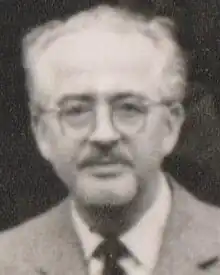Christian Møller
Christian Møller (22 December 1904 in Hundslev, Als – 14 January 1980 in Ordrup) was a Danish chemist and physicist who made fundamental contributions to the theory of relativity, theory of gravitation and quantum chemistry.[1] He is known for Møller–Plesset perturbation theory[2] and Møller scattering.
Christian Møller | |
|---|---|
 Christian Møller, 1963 at Copenhagen | |
| Born | Christian Møller 22 December 1904 |
| Died | 14 January 1980 (aged 75) |
| Known for | Møller scattering Møller tetrad theory of gravitation Møller velocity Møller–Plesset perturbation theory Kottler–Møller coordinates |
| Awards | Ørsted Medal (1970) |
| Scientific career | |
| Fields | Theoretical physics |
His suggestion in 1938 to Otto Frisch that the newly discovered process of nuclear fission might create surplus energy, led Frisch to conceive of the concept of the nuclear chain reaction, leading to the Frisch–Peierls memorandum, which kick-started the development of nuclear energy through the MAUD Committee and the Manhattan Project.[3]
Møller was the director of the European Organization for Nuclear Research (CERN)'s Theoretical Study Group between 1954 and 1957 and later a member of the same organization's Scientific Policy Committee (1959-1972).[4]
Møller tetrad theory of gravitation
In 1961, Møller[5][6] showed that a tetrad description of gravitational fields allows a more rational treatment of the energy–momentum complex than in a theory based on the metric tensor alone. The advantage of using tetrads as gravitational variables was connected with the fact that this allowed to construct expressions for the energy-momentum complex which had more satisfactory transformation properties than in a purely metric formulation.
Supporting Chandrasekhar
Subrahmanyan Chandrasekhar came up with his theory of the Chandrasekhar limit for the maximum stable mass of a star, in 1930. This calculation was in opposition to Sir Arthur Eddington theories about stars. Eddington mocked Chandrasekhar various times and frequently campaigned against Chandrasekhar during conferences.[7]
In 1935, Møller was the first to write a paper in collaboration with Chandrasekhar to criticise Eddington's theory. They wrote "we are quite unable to follow [Eddington's] arguments." They also proceeded to refute Eddington's follow up paper showing contradictions in his theory.[7]
Books
- The world and the atom, London, 1940.[8]
- The theory of relativity, Clarendon Press, Oxford, 1972.
- A study in gravitational collapse, Kobenhavn : Munksgaard, 1975.
- On the crisis in the theory of gravitation and a possible solution, Kobenhavn : Munksgaard, 1978.
- Evidence for gravitational theories (ed.), Academic Press, 1963.
- Interview with Dr. Christian Moller by Thomas S. Kuhn at Copenhagen July 29, 1963 Oral History Transcript — Dr. Christian Moller
References
- Turkevich, John; Turkevich, Ludmilla (1980). Prominent scientists of continental Europe. Elsevier. ISBN 0-444-00046-1.
- Kragh, Helge (1992). "Relativistic Collisions: The Work of Christian Møller in the Early 1930s". Arch. Hist. Exact Sci. 43 (4): 299–328. doi:10.1007/BF00374762. S2CID 121494792.
-
- Frisch, Otto Robert (1979). What Little I Remember. Cambridge: Cambridge University Press. p. 118. ISBN 978-0-521-28010-5. OCLC 911308407.
- Pors, Felicity. "Møller, Christian (1904-1980)". Niels Bohr Archive. Retrieved 2019-07-12.
- Møller, Christian (1961). "Conservation laws and absolute parallelism in general relativity". Mat. Fys. Dan. Vid. Selsk. 1 (10): 1–50.
- Møller, Christian (1961). "Further remarks on the localization of the energy in the general theory of relativity". Ann. Phys. 12 (1): 118–133. Bibcode:1961AnPhy..12..118M. doi:10.1016/0003-4916(61)90148-8.
- Mena, J. G.; Peres, T. S. C. (2018). "Chandrasekhar Eddington". Maths History. Retrieved 2023-09-04.
- The National Library of Australia's Catalogue